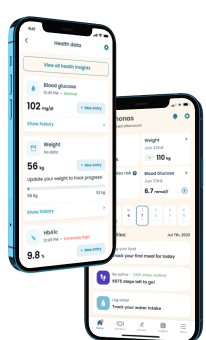How to Manage Type 2 Diabetes

Around 30 million people in the U.S. have type 2 diabetes. In many cases, this condition can be naturally reversed with the help of a balanced diet and an active lifestyle. Today, we will explore what you can do right now to ease the symptoms and discuss the possibility of reversing type 2 diabetes completely without taking medicine. Whether you will succeed highly depends on your specific case. However, forming new, healthier habits will benefit your health and slow down the progression of diabetes either way.
When diagnosed with type 2 diabetes, people often blame themselves for making poor lifestyle choices in the past. Unfortunately, looking back never helps. It’s always best to take full responsibility for the choices you made, learn from them and move on. What you can do is fix some of the damage with the choices you will make from here on.
Numerous studies have found that with the right action plan, type 2 diabetes can be reversed. However, you need to open your mind and accept that things will have to change. Identifying the problem and understanding the reasons behind it is the first step towards a healthier, happier life and hopefully – a life without diabetes.
What Foods Should You Eat to Better Manage Diabetes?
We all know that eating healthy is good for us. So, why aren’t we doing it? Why are there millions of obese people in the world? It’s not all genetics. It’s not all about overpriced organic food. It’s because health is not always a priority, however unreasonable it may sound. Until your doctor tells you that you need to cut back on sugar. And even then, some of us would last less than a week.
We tend to “eat our emotions,” grab “quick bites” and even reward ourselves with something extra greasy or sweet, thinking, “I deserve this.” However, it’s all deeply connected. We need to re-think and rewire our relationship with food if we want to make sustainable dietary changes. When it comes to reversing diabetes, it’s not about fitting into a pair of skinny jeans. It’s about avoiding complications that would make your life a whole lot more difficult than practicing a healthy diet could ever be.
The basic truth is – you can only maintain consistent blood sugar levels by following a balanced diet. It’s as simple as that. Understanding your body’s needs can go a long way toward diabetes prevention.

If you have type 2 diabetes, you should always choose foods that have a low glycemic index (foods high in fiber, protein, or fats), like vegetables and protein that you find in fish, lentils, and beans. In addition, a balanced diet would also include fruit, whole grains, nuts, and low-fat dairy products.
Foods with a high glycemic index raise your blood sugar, so try to avoid processed foods that are high in sugars, carbohydrates, or animal fat (sweets, pastries, chips, desserts, bread, pasta, and crackers).
Can Exercise Help Manage Type 2 Diabetes?
Staying physically active plays a huge role in naturally reversing type 2 diabetes. Regular exercise helps to control blood glucose levels, benefits your heart, lowers blood pressure, reduces harmful LDL cholesterol and triglycerides, raises healthy HDL cholesterol, strengthens your muscles, reduces weight, and, most importantly, increases your body’s sensitivity to insulin.



The main fuel sources that your body uses during exercise are lipids and carbohydrates. With high-intensity exercises, the need for carbohydrates becomes even greater. Initially, muscle contraction uses stores of ATP and glycogen in the muscle itself. During prolonged exercise, a shift occurs to the use of outside sources of energy, including free fatty acids and blood glucose.
Blood Glucose Monitoring During Sports
1-3 hours after eating is the best time to start your exercising routine – that’s when your blood sugar levels are higher. If you are taking insulin, you should always test your blood sugar before exercising and eat a piece of fruit if the numbers have dropped.
Make sure that you check your blood sugar after any particularly intense workout or activity. The risk of developing hypoglycemia may be the highest 6-12 hours after exercising. If your blood sugar is too high (over 250 mg/dL), you should avoid exercising until it drops because it may lead to diabetic ketoacidosis. Careful monitoring is the only way to make sure that your blood sugar level remains within your target range. Before starting your workout plan, you should definitely consider consulting your doctor – he/she will let you know what testing regimen would work best for you.
Ideally, you should aim for at least 30 minutes or more of aerobic exercise most days of the week. If you haven’t been active for a while, start slowly and build up gradually.
Reducing Stress
When it comes to diabetes, emotional well-being often gets overlooked. However, a number of research studies have identified stressors such as family losses and workplace stress as factors triggering the onset of type 2 diabetes.
Now, as we all know, avoiding stress altogether is practically impossible. However, practicing mindfulness, meditation, and breathing exercises can really help you to control your reaction to stressors.
So, try to find a peaceful moment in your daily routine to practice mindful breathing. That could be anytime – in the evening before bedtime or even during your lunch break at work.
Just close your eyes and focus on the pure sensations of breathing. Inhale and notice what the air feels like moving through your nose or mouth. Exhale and feel the new sensations. Notice how the air moves from your chest through your throat, nose, and mouth. Allow your body to fully relax and feel your own presence. Aim to practice mindful breathing for 10 minutes every other day.
Bottom Line
The end goal of diabetes management is to lower your blood sugar to a normal level. This would prevent (or at least delay) problems and complications that can be caused by diabetes. Aside from medications, only a healthy diet and regular exercise can help you achieve that.
Did you find this information helpful? Check out what others think about the Klinio program here.
Take a quiz and get your diabetes-management plan today!










